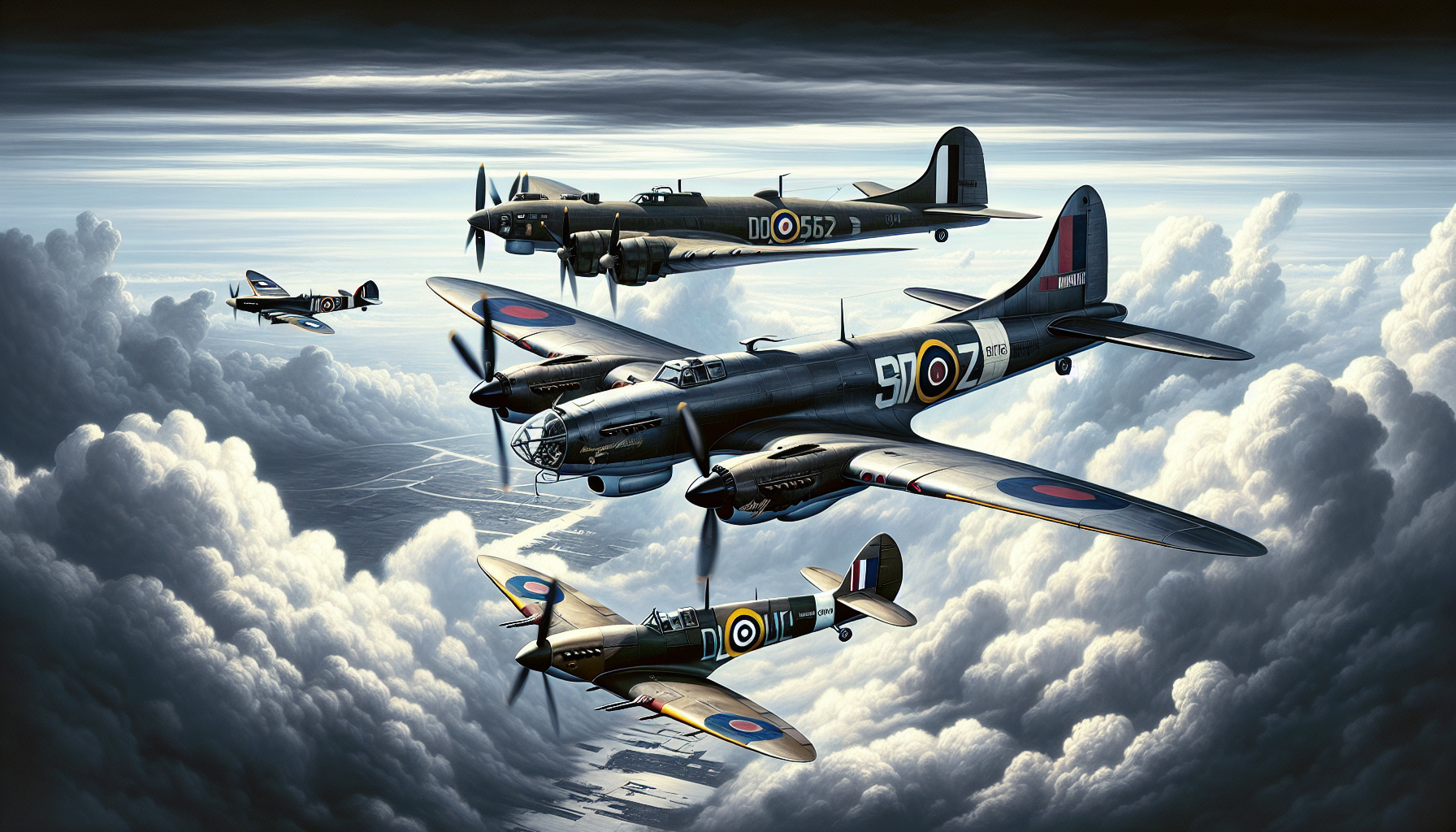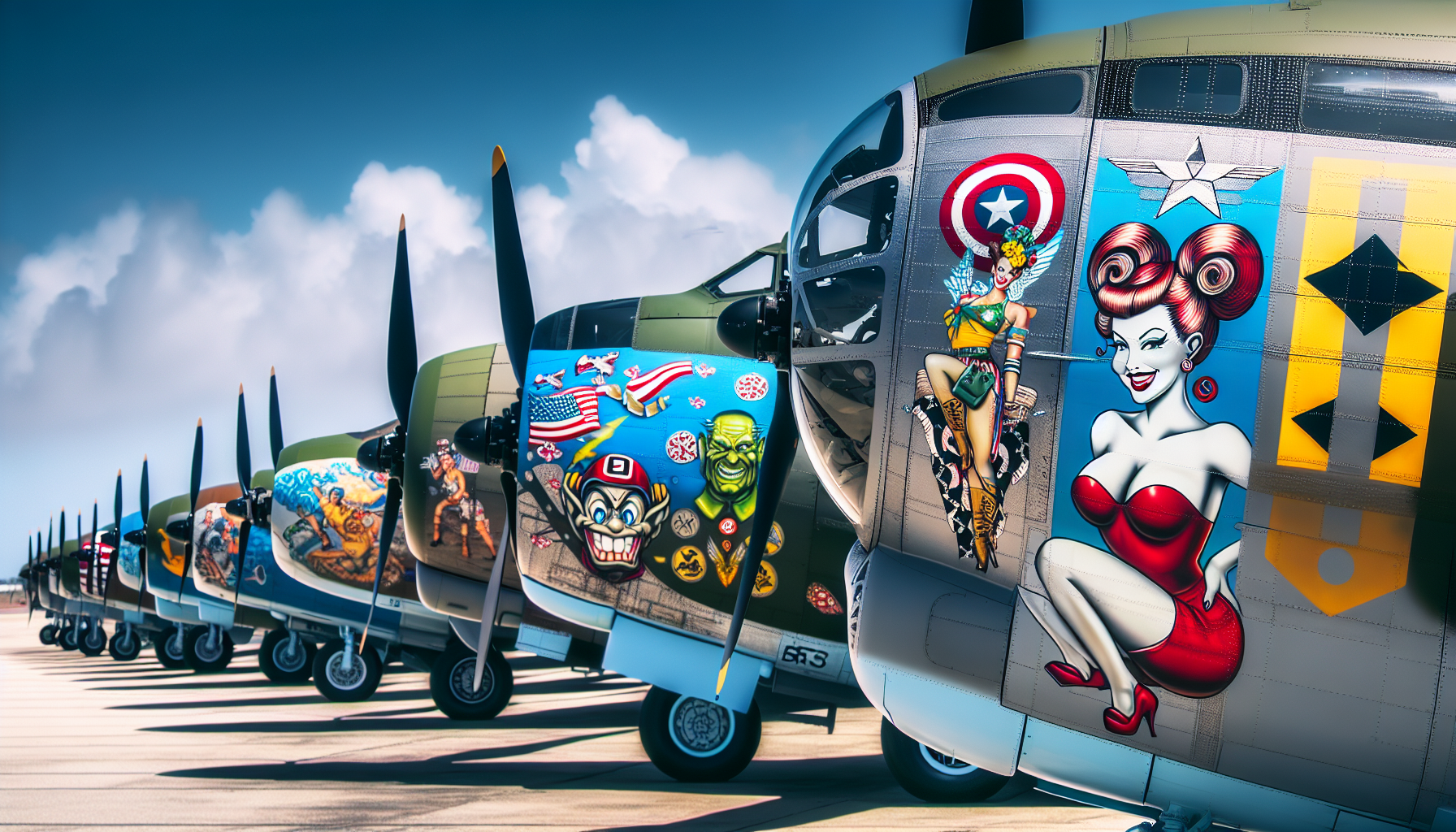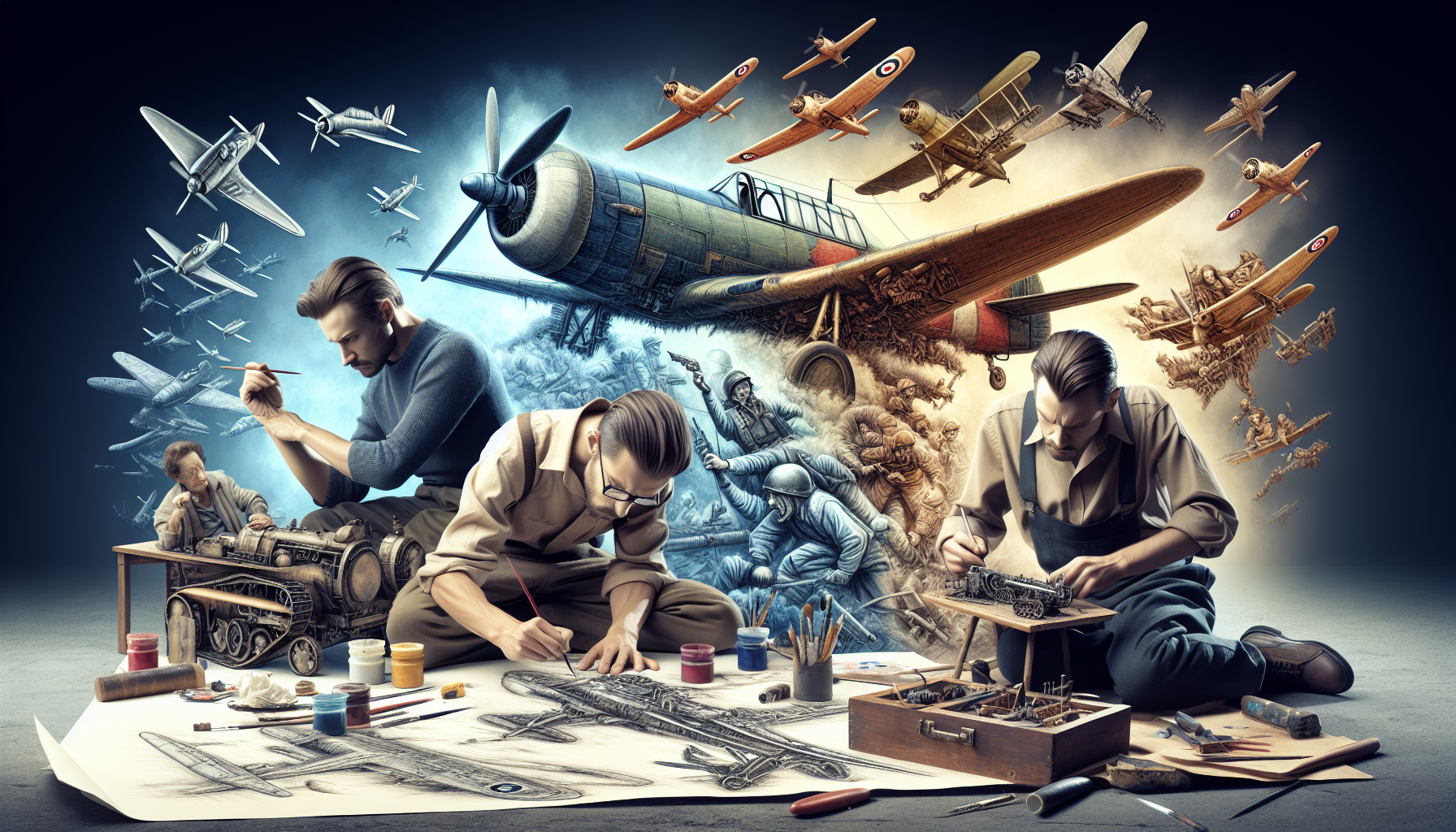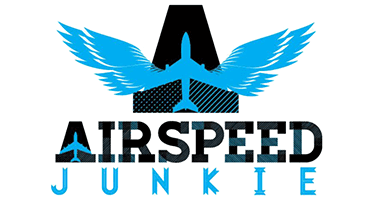Top World War 2 Plane Art: Capturing History Through Iconic Designs
WWII plane art turned aircraft into personalized symbols of morale and identity. The beginning of nose art as a tradition in military aviation can be traced back to early decorative markings, which evolved into a widespread practice during World War II. Discover the history, famous examples, and the impact of these artworks on bombers and fighters, capturing the bravery of pilots in World War II.
Key Takeaways
-
WWII aviation art captures iconic aircraft and battles, celebrating their roles and the heroism of the pilots, with notable planes like the Supermarine Spitfire, Boeing B-17 Flying Fortress, and Hawker Hurricane frequently depicted.
-
Legendary pilots and their signature aircraft are a recurring theme in WWII aviation art, exemplified by Johnny Baldwin’s Hawker Typhoon, Bob Cross’s Spitfire, and Captain Abner Aust’s P-51 Mustang, highlighting their heroic deeds and technical mastery.
-
The practice of nose art on WWII planes served as a form of personal expression for crews, featuring diverse themes from pin-up girls to fierce animals, enhancing morale and individualizing aircraft amidst the uniformity, with notable examples including ‘Memphis Belle’ and ‘Dragon and His Tail’.
Iconic WWII Aircraft in Art

The skies of World War II were dominated by aircraft soaring through the open sky, becoming legends not just for their engineering brilliance but also for their pivotal roles in the war. Aviation art has beautifully captured these iconic planes, portraying them in moments of valor and technological prowess. Among the most celebrated in this genre are the Supermarine Spitfire, Boeing B-17 Flying Fortress, and Hawker Hurricane.
Artists have breathed life into these aircraft, transforming them from mere machines into enduring symbols of courage and resilience. Across a range of artistic mediums—from oil paintings to evocative black-and-white photographs—iconic WWII planes are depicted in dramatic flight, formation, and even on the ground, capturing their unique lines, power, and the stories they carry. Artworks often feature legendary fighter groups like the 361st Fighter Group of the Eighth Air Force, immortalizing the aircraft and the squadrons that shaped air history.
Supermarine Spitfire
The Supermarine Spitfire stands as a testament to British ingenuity and perseverance during World War II. Known for its critical role in the Battle of Britain, this aircraft’s sleek design and agility made it a formidable opponent in the skies. Aviation art often portrays the Spitfire amidst the chaos of aerial dogfights, showcasing its iconic elliptical wings and the daring pilots who flew them.
Beyond highlighting the aircraft’s physical beauty, these depictions underscore its symbolic role as a beacon of hope and strength. Many artists also explore the Spitfire’s legacy through vintage prints and modern renditions, giving viewers a sense of its enduring allure and the legacy of those who piloted these machines.
Boeing B-17 Flying Fortress
The Boeing B-17 Flying Fortress is celebrated as a bomber-based aircraft, renowned for its robustness and strategic importance in long-range bombing missions over Europe. Aviation art captures the dramatic scenes of these bombers in formation, navigating perilous skies filled with enemy flak during each mission. These artworks emphasize the courage of the airmen and the critical role the B-17 played in the Allied victory.
With its distinctive design and formidable firepower, the Flying Fortress symbolizes the relentless pursuit of victory in the air force and continues to captivate aviation artists.
Hawker Hurricane
The Hawker Hurricane, though often overshadowed by the Spitfire, was a key player in achieving air superiority during the Battle of Britain. Aviation art frequently pairs the Hurricane with the Spitfire, highlighting its effectiveness against enemy bombers and its robust design.
Such artworks encapsulate moments of intense aerial combat and heroic feats, celebrating the Hurricane’s vital contributions and the brave pilots who defended Britain. Artists often pay particular attention to the Hurricane’s rugged lines and the stoic determination of its pilots, bringing to life the aircraft’s role in pivotal air battles.
P-51 Mustang and P-40 Warhawk in Flight
Beyond the familiar silhouettes of the Spitfire and Hurricane, aviation art often features other icons like the P-51 Mustang and the P-40 Warhawk. These aircraft, captured in dynamic flight by artists and photographers alike, represent the technological leaps and diverse theaters of WWII air combat. Whether shown soaring above the clouds or banking into a turn, these planes embody the speed, power, and innovation of the era.
Diverse Perspectives: The Human Element
Aviation art doesn’t just celebrate machines—it also honors the people behind them. Photographs and paintings of pilots, ground crew, and even cadets, such as African American trainee L. Deitz at a Naval Air Base, bring a human face to the stories of WWII aviation. These works remind viewers of the diverse backgrounds and collective effort that powered the Allied air campaign.
Legendary Pilots and Their Planes
The stories of legendary pilots and their planes are a significant theme in WWII aviation art. These artworks not only depict the aircraft but also the heroism and skill of the pilots who flew them. Figures like Johnny Baldwin, Bob Cross, and Captain Abner Aust have been immortalized through these vivid portrayals, capturing their daring feats and the unique characteristics of their planes.
We’ll now examine the lives of these remarkable individuals and the aircraft they flew.
Johnny Baldwin’s Hawker Typhoon
Johnny Baldwin’s prowess as a pilot is legendary, particularly his mastery of the Hawker Typhoon. Known for its powerful armament and impressive speed, the Typhoon was a force to be reckoned with in ground-attack missions. Baldwin, as the top-scoring pilot on this aircraft, demonstrated exceptional skill and bravery.
The might of the Typhoon and Baldwin’s remarkable achievements are often captured in aviation art.
Bob Cross’s Spitfire
Bob Cross’s Spitfire is another iconic subject in aviation art, frequently depicted in significant aerial battles. Cross’s flying skills and the Spitfire’s agility are highlighted in artworks that capture the intensity of these encounters. Notably, his victory over a Japanese aircraft from Japan on Boxing Day, 1943, is a popular theme, emphasizing both his prowess and the strategic importance of the Spitfire.
Captain Abner Aust’s P-51 Mustang
Captain Abner Aust’s P-51 Mustang is celebrated for its speed and firepower, essential attributes in aerial dogfights. Aust’s tactical acumen and the Mustang’s performance are frequently depicted in aviation art, illustrating pivotal moments in battles over Nagoya and Tokyo.
These artworks not only highlight the technical brilliance of the P-51 but also the strategic genius of Aust, making them treasured pieces for enthusiasts.
Battle Scenes in Aviation Art
Battle scenes in aviation art bring to life the intense and heroic moments of WWII aerial combat, often depicted through painting. These artworks capture the essence of the battles, showcasing both the aircraft and the pilots in action. From the ferocious dogfights of the Battle of Britain to the strategic duels over Europe and the exotic conflicts in the Pacific Theater, these paintings chronicle the bravery and skill that defined the air war.
We’ll now turn our attention to some of the most iconic battle scenes represented in aviation art.
Battle of Britain
The Battle of Britain is a focal point in aviation art, illustrating the fierce dogfights between the RAF and the Luftwaffe. These artworks highlight the heroism of the RAF pilots as they defended their homeland against overwhelming odds.
Paintings like the painted ‘Combat Over The Channel’ vividly capture the dramatic aerial combat, offering a sense of the bravery and skill required in these high-stakes battles, as viewers search for details in the scene.
Duel Over Europe
The European theater was home to some of the most intense aerial confrontations of WWII, with many dramatic battles taking place over Germany or involving German forces. Artworks like ‘Duel in the Dark’ by Robert Taylor depict these dramatic battles, showcasing the strategic maneuvers and bravery of the pilots. Beyond the action, these scenes capture the human element, encapsulating the tension and heroism that pervaded these encounters.
Pacific Theater Conflicts
Aviation art depicting the Pacific Theater emphasizes:
-
The exotic and challenging environments where aerial battles took place
-
The unique landscapes of the Pacific
-
The fierce dogfights that occurred over the vast expanses of the Pacific.
Navy aircraft played a crucial role in these conflicts, with some naval planes featuring nose art despite official restrictions, reflecting the individuality and spirit of their crews.
The depictions of these conflicts highlight the adaptability and bravery of the pilots during their flight as they faced both the enemy and the elements.
Unique Nose Art of WWII Planes

Nose art on WWII planes served as a canvas for personal expression, with personalized markings that adorned the aircraft and reflected the crew's personalities and the times. From humorous caricatures to risqué pin-ups, these unofficial markings provided psychological protection and boosted morale.
We’ll now turn our focus to the origins, famous examples, and artistic styles of this unique form of aviation art.
Origins and Significance
Nose art originated during World War I as a practical way to differentiate friendly aircraft from the enemy. By WWII, it evolved into a form of personal expression, with American forces adopting the practice from their European counterparts. These artworks often featured fierce animals, family crests, and symbols that evoked memories of home, serving as a rite of passage for air crews.
This personal touch transformed the otherwise standardized machines, giving each aircraft its own unique identity through service. From a military standpoint, nose art became a significant part of military culture, boosting morale and fostering group identity among service members. Viewed from an anthropological perspective, nose art offers valuable insight into the cultural and social dynamics of military life during WWII, revealing how symbols and imagery reflected the values, anxieties, and identities of those who served.
Famous Examples
Some of the most famous examples of WWII nose art include:
-
The ‘Memphis Belle,’ named after pilot Captain Robert K. Morgan’s sweetheart, featured a pin-up girl designed by artist George Petty.
-
‘Enola Gay,’ known for dropping the atomic bomb on Hiroshima, simply featured the aircraft’s name.
-
The ‘Dragon and his Tail’ on a B-24 Liberator is one of the largest known pieces of nose art, showcasing the creativity and craftsmanship of the era.
Similarly, many nose art designs depicted women, serving as both popular culture icons and symbols of femininity, while others were created as a gift or to honor loved ones, reflecting the personal and commemorative nature of these decorations.
Artistic Styles
The artistic styles in WWII nose art were incredibly diverse, ranging from:
-
pin-up girls
-
mascots
-
animals
-
cartoon characters
Themes included lucky symbols like dice and playing cards, as well as references to mortality such as the Grim Reaper. American nose art was often inspired by pinups, cartoons, patriotic characters, and fictional heroes, reflecting the cultural attitudes of the time.
Gender metaphor played a significant role in nose art, with many images painted directly onto the fuselage using paint. Popular cartoon characters, including Mickey Mouse, were also frequently featured.
While some of these portrayals are now considered offensive, they offer a glimpse into the era’s mindset and the ways in which aircrews coped with the stresses of war.

Artists Who Immortalized WWII Planes
The legacy of WWII aviation art is preserved through the works of talented artists who have meticulously captured the aircraft and moments of the war. Many artists relied on historical photos and pictures to ensure accuracy in their depictions, drawing inspiration from authentic visual references of nose art and military planes. Artists like Darryl Legg, Chris French FGAvA, and Roger H. Middlebrook GAvA have dedicated their careers to bringing these historical scenes to life. Their detailed depictions serve not only as artistic masterpieces but also as historical records that keep the memories of these iconic planes and pilots alive.
We’ll now examine the contributions of these select notable artists.
Darryl Legg
Darryl Legg is renowned for his realistic portrayals of WWII aviation scenes and his precise illustrations of iconic aircraft. His works, such as ‘Burma Victory’ and ‘Close Encounter,’ showcase detailed battle scenes and the aircraft involved, capturing the essence of the era.
Collectors and enthusiasts alike highly seek after Legg’s pieces, thanks to his meticulous attention to detail and historical accuracy.
Chris French FGAvA
Chris French FGAvA specializes in capturing the technical and historical aspects of various WWII aircraft and pivotal aviation moments. His artwork ‘Across The Cornish Coast,’ depicting the Short Sunderland, and his illustration of Short Stirlings during a sudden downpour, highlight his focus on accuracy and detail. French’s work is invaluable to the aviation art community, given his commitment to preserving historical moments through his art.
Roger H. Middlebrook GAvA
Roger H. Middlebrook GAvA is noted for his comprehensive visual history of WWII aviation, combining aircraft and historical battle scenes in his artwork. His pieces provide a detailed and immersive view of the war, capturing both the technical aspects of the aircraft and the human stories behind them. Middlebrook’s ability to blend historical accuracy with artistic expression makes his work a significant contribution to the field of aviation art.
Collecting WWII Aviation Art
Collecting WWII aviation art is a passion that combines a love for history, art, and aviation. The market offers a range of works, from original paintings to limited edition prints and posters. Collectors often seek pieces that hold both historical significance and artistic value, with many preferring artworks that include authentic relics from the aircraft depicted.
Collectors often seek out books published by Motorbooks International for authoritative visual histories of WWII nose art.
We’ll now examine the key aspects of collecting aviation art, encompassing limited edition prints, authenticity, and preservation.
Limited Edition Prints
Limited edition aviation art prints are highly prized by collectors for their exclusivity and artistic value. Typically produced in quantities of 500 or fewer, these prints are often signed and numbered by the artist, enhancing their collectible nature. For example, a limited edition print of Bob Cross’s Spitfire art might be available with only 50 copies, making each piece unique and valuable.
Printed on archival canvas or watercolor paper, these high-quality prints ensure longevity and maintain their rich aesthetic appeal, making them a cherished addition to any collection.
Authenticity and Certification
Ensuring the authenticity of aviation art is crucial for collectors. Certificates of authenticity play a key role in verifying the provenance and originality of each piece. These documents often include signatures from the artist or gallery, and detailed provenance records tracing the artwork’s history and legitimacy.
Acquiring aviation art necessitates checking for these certificates and any additional provenance documents to validate the piece’s value and authenticity. This practice safeguards your investment and upholds the historical significance of the artwork.
Display and Preservation
Maintaining the condition and aesthetic appeal of WWII aviation art requires proper display and preservation. Using UV-resistant glass in framing can help protect the artwork from fading due to light exposure. Proper framing and matting also play a crucial role in preserving the artwork, ensuring it remains in pristine condition for years to come.
Additionally, displaying aviation art in climate-controlled environments can prevent damage from humidity and temperature changes, safeguarding your collection’s longevity and beauty.
Summary
Throughout this exploration of WWII aviation art, we’ve delved into the iconic aircraft that dominated the skies, the legendary pilots who flew them, and the dramatic battle scenes that defined an era. We’ve also uncovered the personal touch of unique nose art and celebrated the artists who have immortalized these historical moments. For collectors, understanding the value of limited edition prints, the importance of authenticity, and the best practices for display and preservation is essential. WWII aviation art is not just a visual delight; it is a testament to courage, innovation, and the enduring spirit of those who lived through the war.
As you embark on your journey into this fascinating world, may these pieces of history inspire and captivate you. The enduring fascination with old warplanes and their decorated histories continues to evoke nostalgia and highlight the cultural significance of these remarkable aircraft.
Frequently Asked Questions
What makes aviation art from WWII so special?
WWII aviation art is special because it captures the essence of the era, showcasing iconic aircraft, legendary pilots, and dramatic battle scenes, serving as a historical record and a tribute to the bravery and innovation of the time. Fighter nose art is a unique and celebrated aspect of WWII aviation art, contributing to its special status by reflecting personal expression, boosting morale, and symbolizing military and national identity.
Why is the Supermarine Spitfire frequently depicted in aviation art?
The Supermarine Spitfire is frequently depicted in aviation art due to its iconic status, sleek design, agility, and crucial role in the Battle of Britain, making it a popular subject for artists.
What are some famous examples of WWII nose art?
Some famous examples of WWII nose art include the ‘Memphis Belle,’ ‘Enola Gay,’ and ‘Dragon and his Tail.’ Another iconic design was the 'shark mouth,' a stylized open jaw painted on the noses of fighter aircraft like the P-40, which became widely recognized and helped boost crew morale. These artworks provided a personal and often humorous touch to the aircraft, boosting crew morale.
How can I ensure the authenticity of a WWII aviation art piece?
To ensure the authenticity of a WWII aviation art piece, check for certificates of authenticity, provenance documents, and signatures from recognized authorities or the artist. This is crucial for verifying its origin and value.
What are the best practices for preserving aviation art?
To preserve aviation art, it's crucial to use proper framing with UV-resistant glass and exhibit the artwork in climate-controlled environments to maintain its condition and aesthetic appeal.







